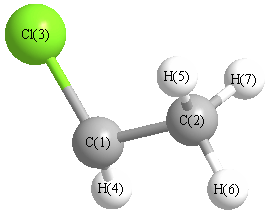Vibrational Frequencies calculated at B2PLYP/cc-pVTZ
| Mode Number |
Symmetry |
Frequency
(cm-1) |
Scaled Frequency
(cm-1) |
IR Intensities
(km mol-1) |
Raman Act
(Å4/u) |
Dep P |
Dep U |
|---|
| 1 |
A |
3242 |
3111 |
5.89 |
|
|
|
| 2 |
A |
3128 |
3001 |
11.36 |
|
|
|
| 3 |
A |
3080 |
2955 |
13.23 |
|
|
|
| 4 |
A |
3005 |
2883 |
19.53 |
|
|
|
| 5 |
A |
1495 |
1435 |
2.71 |
|
|
|
| 6 |
A |
1477 |
1417 |
8.29 |
|
|
|
| 7 |
A |
1419 |
1362 |
5.08 |
|
|
|
| 8 |
A |
1312 |
1258 |
39.46 |
|
|
|
| 9 |
A |
1125 |
1079 |
3.82 |
|
|
|
| 10 |
A |
1047 |
1004 |
18.47 |
|
|
|
| 11 |
A |
1011 |
970 |
0.77 |
|
|
|
| 12 |
A |
737 |
707 |
26.60 |
|
|
|
| 13 |
A |
384 |
368 |
19.84 |
|
|
|
| 14 |
A |
319 |
306 |
12.49 |
|
|
|
| 15 |
A |
152 |
146 |
0.96 |
|
|
|
Unscaled Zero Point Vibrational Energy (zpe) 11466.7 cm
-1
Scaled (by 0.9594) Zero Point Vibrational Energy (zpe) 11001.2 cm
-1
See section
III.C.1 List or set vibrational scaling factors
to change the scale factors used here.
See section
III.C.2
Calculate a vibrational scaling factor for a given set of molecules
to determine the least squares best scaling factor.
Charges, Dipole, Quadrupole and Polarizability
Charges from optimized geometry at B2PLYP/cc-pVTZ
Charges (e)
| Number |
Element |
Mulliken |
CHELPG |
AIM |
ESP |
| 1 |
C |
-0.134 |
|
|
|
| 2 |
C |
-0.284 |
|
|
|
| 3 |
Cl |
-0.092 |
|
|
|
| 4 |
H |
0.156 |
|
|
|
| 5 |
H |
0.123 |
|
|
|
| 6 |
H |
0.114 |
|
|
|
| 7 |
H |
0.117 |
|
|
|
Electric dipole moments
Electric dipole components in Debye
(What's a Debye? See section
VII.A.3)
| |
x |
y |
z |
Total |
| |
1.476 |
0.344 |
0.222 |
1.532 |
| CHELPG |
|
|
|
|
| AIM |
|
|
|
|
| ESP |
|
|
|
|
Electric Quadrupole moment
Quadrupole components in D Å
| Primitive |
|---|
| | x | y | z |
|---|
| x |
-25.084 |
0.334 |
0.051 |
| y |
0.334 |
-25.001 |
0.384 |
| z |
0.051 |
0.384 |
-26.739 |
|
| Traceless |
|---|
| | x | y | z |
|---|
| x |
0.786 |
0.334 |
0.051 |
| y |
0.334 |
0.911 |
0.384 |
| z |
0.051 |
0.384 |
-1.697 |
|
| Polar |
|---|
| 3z2-r2 | -3.394 |
|---|
| x2-y2 | -0.083 |
|---|
| xy | 0.334 |
|---|
| xz | 0.051 |
|---|
| yz | 0.384 |
|---|
|
Polarizabilities
Components of the polarizability tensor.
Units are
Å
3 (Angstrom cubed)
Change units.
| |
x |
y |
z |
| x |
6.882 |
0.327 |
-0.000 |
| y |
0.327 |
4.897 |
-0.018 |
| z |
-0.000 |
-0.018 |
4.000 |
<r2> (average value of r
2) Å
2
| <r2> |
75.680 |
| (<r2>)1/2 |
8.699 |
